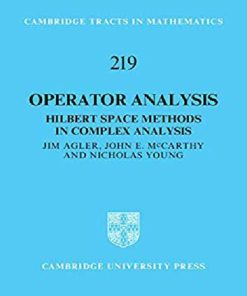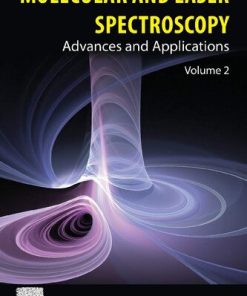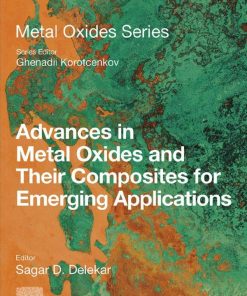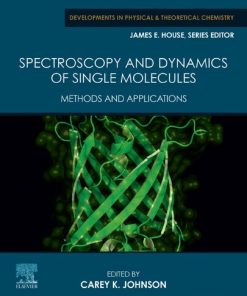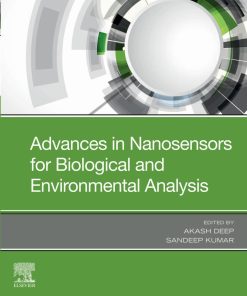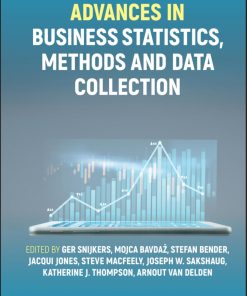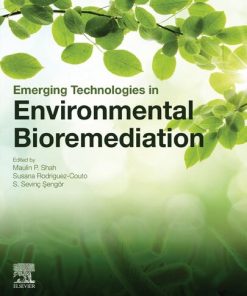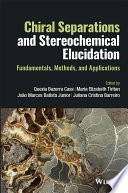(EBook PDF) Chiral Analysis Advances in Spectroscopy Chromatography and Emerging Methods 1st edition by Prasad Polavarapu 0444640282 9780444640284 full chapters
$50.00 Original price was: $50.00.$25.00Current price is: $25.00.
Chiral Analysis: Advances in Spectroscopy, Chromatography and Emerging Methods 1st edition by Prasad L. Polavarapu – Ebook PDF Instant Download/DeliveryISBN: 0444640282, 9780444640284
Full download Chiral Analysis: Advances in Spectroscopy, Chromatography and Emerging Methods 1st edition after payment.
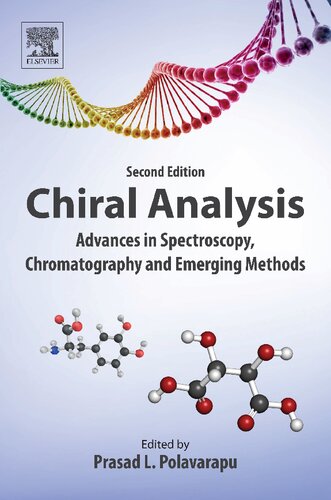
Product details:
ISBN-10 : 0444640282
ISBN-13 : 9780444640284
Author: Prasad Polavarapu
Chiral Analysis: Advances in Spectroscopy, Chromatography and Emerging Methods, Second Edition covers an important area of analytical chemistry of relevance to a wide variety of scientific professionals, including chemistry graduate students, analytical chemists, organic chemists, professionals in the pharmaceutical industry, and others with an interest in chirality and chiral analysis. This thoroughly revised second edition covers several new, important areas of chiral analysis that have emerged since the first edition.
Chiral Analysis: Advances in Spectroscopy, Chromatography and Emerging Methods 1st Table of contents:
Part One – Chirality in Nature
Chapter 1 – Chiral Asymmetry in Nature
1.1 – Introduction
1.2 – Chirality: Terminology and Quantification Issues
1.2.1 – Cahn–Ingold–Prelog classification of chiral molecules
1.2.2 – Optical rotation
1.2.3 – Enantiomeric excess
1.2.4 – Crystal enantiomeric excess
1.2.5 – Chirality measures
1.3 – Chiral Asymmetry in Nature
1.3.1 – Asymmetry in nuclear processes
1.3.2 – Asymmetry in atoms
1.3.3 – Asymmetry in molecules
1.3.4 – Biomolecular asymmetry
1.3.5 – Morphological asymmetry
1.3.6 – Astrophysical asymmetries
1.4 – Theory of Spontaneous Chiral Symmetry Breaking
1.5 – Sensitivity of Chiral Symmetry Breaking Transitions to Asymmetric Interactions
1.6 – Examples of Spontaneous Chiral Symmetry Breaking
1.7 – Concluding Remarks
Acknowledgments
References
Chapter 2 – Remote Sensing of Homochirality: A Proxy for the Detection of Extraterrestrial Life
2.1 – Introduction
2.2 – Homochirality
2.2.1 – The homochirality of life
2.2.2 – The origin of homochirality
2.2.2.1 – The initial imbalance
2.2.2.2 – The amplification of the enantiomeric excess
2.3 – Chemical and biological mechanisms for creating circular spectropolarimetric signals
2.3.1 – The discovery of chirality and its relation to the polarization of light
2.3.2 – Optical rotatory dispersion, electronic circular dichroism, and circular polarization
2.3.3 – Electronic transitions and rotational strength
2.3.4 – Exciton coupling
2.3.5 – Large aggregates (PSI-type)
2.4 – Considerations for the remote sensing of homochirality in our solar system and beyond
2.4.1 – Wavelength considerations
2.4.2 – In situ observations
2.4.3 – Solar system observations (remote)
2.4.4 – Exoplanet observations
2.5 – Instrumentation
2.5.1 – Polarization measurement approaches
2.5.1.1 – Terminology: polarimetric sensitivity and accuracy
2.5.1.2 – Temporal modulation
2.5.1.3 – Snapshot modulation
2.5.2 – Mitigating linear polarization cross-talk
2.5.3 – Current and future instrument concepts
2.6 – Conclusion and outlook
References
Part Two – Spectroscopic Methods and Analyses
Chapter 3 – Light Polarization and Signal Processing in Chiroptical Instrumentation
3.1 – Introduction
Part A—The polarization of light
3.2 – Light as a wave
3.3 – Types of polarized light
3.3.1 – Linearly polarized light
3.3.2 – Circularly polarized light
3.3.3 – Elliptically polarized light
3.4 – Production of linearly polarized light
3.4.1 – Polarization by scattering
3.4.2 – Polarization by reflection and refraction
3.4.3 – Polarization by birefringence
3.4.4 – Polarization by wire grids
3.4.5 – Polarization by dichroism
3.5 – Production of circularly polarized light
3.6 – Production of elliptically polarized light
3.7 – Photoelastic modulators
Part B—Signal handling
3.8 – Noise in electrical circuits
3.8.1 – White noise
3.8.2 – Flicker noise
3.9 – Noise reduction strategies
3.9.1 – Amplitude modulation
3.9.2 – Demodulation
3.9.3 – Implementing phase-sensitive detection
3.9.4 – Implementing modulation
3.9.5 – Benefits of modulation and synchronous demodulation
3.10 – Application of phase-sensitive detection in chiroptical instrumentation
Appendix a basic optics
A1 – Refractive index
A2 – Snell’s law
A3 – Lissajous figures and forms of polarization
A3.1 – Linear polarization
A3.2 – Circularly polarized light
A4 – The law of malus
A5 – The faraday effect
Appendix B – Signal handlinga
B1 – Phasor basics
B2 – Rc filter basics
B3 – Bode plots
B4 – Signal-To-Noise Basics
B5 – Signal averaging
B6 – Signal integration
B7 – Mathematical basis for amplitude modulation and synchronous demodulation
References
Chapter 4 – Chiroptical Spectroscopic Studies on Soft Aggregates and Their Interactions
4.1 – Introduction
4.1.1 – Optical rotatory dispersion
4.1.2 – Circular dichroism
4.1.2.1 – Electronic circular dichroism
4.1.2.2 – Vibrational circular dichroism
4.1.3 – Vibrational roa
4.2 – Or studies
4.2.1 – Chiral surfactants
4.2.2 – Achiral surfactants
4.2.3 – Chiral probes in achiral surfactants
4.2.4 – Interaction between achiral surfactants and polypeptides
4.2.5 – Inorganic cage complexes
4.2.6 – Molecular dynamics simulations and quantum chemical predictions for chiral surfactants
4.3 – ECD studies
4.3.1 – Chiral surfactants
4.3.2 – Achiral surfactants
4.3.3 – Chiral probes in achiral surfactants
4.3.4 – Interaction between surfactants and proteins/peptides
4.3.5 – Interaction between surfactants and DNA aggregates and related materials
4.3.6 – Induced ECD
4.3.7 – Interaction between surfactants and charge transfer complexes
4.3.8 – Interaction between surfactants and β-cyclodextrin
4.3.9 – Interaction between surfactants and polymers
4.4 – VCD studies
4.4.1 – Chiral surfactants
4.4.2 – Chiral surfactant films
4.4.3 – Interaction between chiral organic molecules and achiral surfactants
4.4.4 – Interaction between chiral polypeptides and achiral surfactants
4.4.5 – Limitations on the use of VCD for studying soft aggregates
4.5 – ROA studies
4.5.1 – ROA studies on surfactants
4.5.2 – ROA studies on protein–surfactant interactions
4.6 – Summary
Acknowledgment
References
Chapter 5 – Vibrational Optical Activity in Chiral Analysis
5.1 – Introduction
5.2 – Definitions of VOA
5.3 – Measurement of VOA
5.4 – Theoretical basis of VOA
5.4.1 – Theory of VCD
5.4.2 – Theory of ROA
5.5 – Calculation of VOA
5.6 – Determination of AC
5.7 – Determination of ee of multiple chiral species
5.8 – VOA of solids and formulated products
5.9 – Summary and conclusions
References
Chapter 6 – Raman Optical Activity
6.1 – Fundamental principles
6.1.1 – The ROA observables
6.1.2 – Instrumentation
6.2 – Experimental ROA studies
6.2.1 – Proteins
6.2.2 – Nucleic acids
6.2.3 – Viruses
6.2.4 – Carbohydrates
6.2.5 – Natural products
6.3 – Enhancement of ROA signals
6.3.1 – Surface-enhanced ROA
6.3.2 – Enhancement of ROA by other approaches
6.4 – Recent ROA instrumentation developments
6.5 – Computational modeling of ROA spectra
6.5.1 – Standard computational approaches today
6.5.2 – Insights gained from ROA calculations
6.6 – Concluding remarks: Future opportunities
References
Chapter 7 – Chiral Molecular Tools Powerful for the Preparation of Enantiopure Compounds and Unambig
7.1 – Introduction
7.2 – Methodologies for determining ac and their evaluations
7.2.1 – Nonempirical methods for determining ACs of chiral compounds
7.2.2 – Relative methods for determining AC using an internal reference with known AC
7.3 – Methodologies for chiral synthesis and their evaluations
7.3.1 – Enantioresolution of racemates
7.3.2 – Asymmetric syntheses
7.4 – Camphorsultam dichlorophthalic acid, csdp acid (−)-1, and camphorsultam phthalic acid, csp a
7.4.1 – Application of the CSP acid method to various alcohols
7.4.2 – Application of the CSDP acid method to various alcohols
7.5 – A novel chiral molecular tool, 2-methoxy-2-(1-naphthyl)-propionic acid {mαnp acid (s)-(+)-2},
7.5.1 – Facile synthesis of MαNP acid 2 and its extraordinary enantioresolution with natural (−)-
7.5.2 – The 1H NMR diamagnetic anisotropy method for determining the AC of secondary alcohols: the s
7.5.3 – Enantioresolution of various alcohols using MαNP acid and simultaneous determination of the
7.6 – Complementary use of csdp acid (−)-1 and mαnp acid (s)-(+)-2 for enantioresolution of alcoh
7.6.1 – Application to various alcohols including diphenylmethanols
7.6.2 – Synthesis of enantiopure cryptochiral hydrocarbon, (R)-(+)-[VCD(−)984]-4-ethyl-4-methyloct
7.7 – Conclusions
Acknowledgments
References
Chapter 8 – Chiroptical Probes for Determination of Absolute Stereochemistry by Circular Dichroism E
8.1 – Introduction
8.2 – A Chiroptical Probe for Chiral Resolution and Determination of the Absolute Configuration o
8.3 – A Chiroptical Probe for Determination of the Absolute Configuration of Primary Amines
8.4 – A Chiroptical Probe for Chirality Transcription and Amplification by the Forming of [2]Pseu
8.5 – Conclusions
Acknowledgments
References
Chapter 9 – Chiral Analysis by NMR Spectroscopy: Chiral Solvating Agents
9.1 – Introduction
9.2 – Low-molecular-weight csas
involving ion pairing processes
9.4 – Molecular tweezer CSAS
9.5 – Synthetic macrocycle CSAS
9.6 – Cyclodextrins
9.7 – Natural products
9.8 – Lyotropic chiral liquid crystals
9.9 – Chiral sensing
9.10 – Configurational assignments
9.11 – Conclusions
References
Chapter 10 – Chiroptical Spectroscopy of Biofluids
10.1 – Introduction
10.2 – Blood and blood-based derivatives
10.2.1 – Electronic circular dichroism
10.2.2 – Vibrational circular dichroism
10.2.3 – Fluorescence-detected circular dichroism
10.2.4 – Raman optical activity
10.3 – Hen egg white
10.4 – Vitreous humor
10.5 – Urine
10.6 – Chiroclinics—chiroptical methods as diagnostic tools
10.6.1 – Cancer and degenerative diseases
10.6.2 – Metabolic disorders
10.7 – Concluding remarks
Acknowledgments
References
Part Three – Chromatographic and Electromigration Methods
Chapter 11 – Chiral Gas Chromatography
11.1 – Introduction
11.2 – Commercial Stationary Phases
11.2.1 – Chiral amino acid derivatives
11.2.2 – Cyclodextrins
11.2.2.1 – Structures of cyclodextrins
11.2.2.2 – Preparation of cyclodextrin-based columns
11.2.2.3 – Mechanism of separation
11.2.2.3.1 – Inclusion interactions
11.2.2.3.2 – Surface interactions
11.2.2.3.3 – Effect of substituents
11.2.2.4 – Applications
11.2.2.5 – Applications in two-dimensional gas chromatography (2D-GC)
11.3 – Non-commercial Stationary Phases
11.3.1 – Cyclofructans
11.3.1.1 – Structure
11.3.1.2 – Mechanism of separation (PM-CF6 and PM-CF7)
11.3.1.3 – Mechanism of Separation (DP-TA-CF6 and DP-PN-CF6)
11.3.1.4 – Applications
11.3.2 – Metal-organic framework
11.3.2.1 – Mechanism of separation
11.3.2.2 – Applications of MOFs
11.3.3 – Porous organic cages
11.3.3.1 – Mechanism of separation
11.3.3.2 – Applications as chiral GC stationary phase
11.3.3.2.1 – CC3
11.3.3.2.2 – CC9 and CC10
11.3.4 – Chiral ILs
11.4 – Conclusions
References
Chapter 12 – Chiral Liquid Chromatography
12.1 – Introduction
12.2 – Historical background of chiral liquid chromatography
12.3 – Interactions in chiral liquid chromatography
12.4 – Chiral separations in liquid chromatography today
12.5 – Salient features of chiral liquid chromatography
12.6 – Major classes of modern chiral stationary phases (csps) for liquid chromatography: the “α
12.6.1 – Polysaccharide CSPs
12.7 – Packing process of high-efficiency chiral phases (“n” in the resolution equation)
12.8 – Method development in chiral lc (adjustment of “k” in the resolution equation)
12.9 – Special detectors in liquid chiral chromatography
12.10 – Recent developments in enhancing chiral resolution using ultrahigh efficiency supports
12.10.1 – Choice of Particle Morphology for Chiral Chromatography: Fully Porous or Superficially Por
12.11 – Instrumental considerations for fast chiral LC
12.12 – Future directions and developments in chiral liquid chromatography
References
Chapter 13 – Enantioseparations by Capillary Electromigration Techniques
13.1 – Introduction
13.2 – Separation principle in chiral ce: electrophoretic or chromatographic?
13.3 – Enantioseparations with charged and uncharged chiral selectors
13.4 – Enantioselective and nonselective phenomena in chiral cekc
13.5 – Similarities and differences between enantioseparations by pressure-driven chromatography and
13.6 – Modes of enantioseparations in cekc
13.7 – Chiral selectors
13.8 – Selector–selectand interaction in chiral CE
13.9 – Mathematical models of ce enantioseparations
13.10 – Enantioseparations in capillary electrochromatography
13.10.1 – Enantioseparations in wall-coated open tubular capillaries
13.10.2 – Enantioseparations in capillaries packed with achiral stationary phases in combination wit
13.10.3 – Enantioseparations in capillaries packed with CSPs
13.11 – Future trends
References
Further Readings
Chapter 14 – Recent Developments in Chiral Separations by Supercritical Fluid Chromatography
14.1 – Introduction
14.2 – Chiral stationary phases for sfc
14.3 – Analytical separations
14.3.1 – Polysaccharide CSPs
14.3.2 – Pirkle-type CSPs
14.3.3 – Macrocyclic glycopeptide antibiotic CSPs
14.3.4 – Ion exchange CSPs
14.3.5 – Cyclodextrin CSPs
14.4 – Ultrafast high-efficient sfc separations
14.4.1 Preparative separations
14.4.1.1 – pSFC Versus pHPLC
14.4.2 Application and strategy
14.5 – Conclusions
References
Chapter 15 – Chiral Separation Strategies in Mass Spectrometry: Integration of Chromatography, Elect
15.1 – Introduction
15.2 – Chromatography and mass spectrometry
15.3 – Liquid chromatography
15.4 – Electrophoresis–mass spectrometry
15.5 – Isomer separations by im–ms
15.6 – Conclusions
Acknowledgements
References
Part Four – Emerging Methods
Chapter 16 – Cavity-based Chiral Polarimetry
16.1 – Introduction
16.2 – Optical activity
16.3 – Single-pass polarimetry
16.4 – Cavity ring-down polarimetry
16.5 – Cavity ring-down polarimetry with signal reversals
16.6 – Continuous-Wave Cavity-Enhanced polarimetry with signal reversals
16.7 – Future outlook and conclusions
Acknowlegements
References
Chapter 17 – Quantitative Chiral Analysis by Molecular Rotational Spectroscopy
17.1 – Introduction
17.1.1 – Challenges in quantitative chiral analysis
17.1.2 – Rotational spectroscopy for chemical analysis
17.1.3 – Bringing enantiomer-specific measurement capabilities to rotational spectroscopy
17.2 – Basic principles of molecular rotational spectroscopy
17.2.1 – Molecular rotational spectroscopy
17.2.2 – Challenges for large molecule rotational spectroscopy
17.2.3 – Molecular structure from rotational spectroscopy
17.2.4 – Advances in rotational spectroscopy for chemical analysis
17.2.5 – An example—diastereomer identification in fenchyl alcohol
17.3 – Chiral tag rotational spectroscopy for enantiomer analysis
17.3.1 – Determination of absolute configuration
17.3.2 – An example—the absolute configuration of 3-methylcyclohexanone
17.3.3 – Measurement of the EE
17.3.4 – An example—EE in fenchyl alcohol
17.3.5 – Challenges and the future for chiral tag rotational spectroscopy
17.4 – Three-wave mixing rotational spectroscopy for enantiomer analysis
17.4.1 – An example—the predominant enantiomer of menthone in buchu oil
17.4.2 – Challenges and the future for three-wave mixing rotational spectroscopy
17.5 – Conclusions
People also search for Chiral Analysis: Advances in Spectroscopy, Chromatography and Emerging Methods 1st:
chiral analysis advances in spectroscopy
what is chiral analysis
spectroscopy in food analysis
applications of spectral analysis
chiral drugs an overview
Tags:
Chiral Analysis,Advances,Spectroscopy,Chromatography,Emerging Methods,Prasad Polavarapu
You may also like…
Uncategorized
Engineering
Molecular and Laser Spectroscopy: Advances and Applications: Volume 2 1st Edition V.P. Gupta
Technique - Materials
Advances in Metal Oxides and Their Composites for Emerging Applications Sagar D. Delekar
Chemistry
Spectroscopy and Dynamics of Single Molecules: Methods and Applications 1st Edition Carey Johnson
Business & Economics - Econometrics
Advances in Business Statistics, Methods and Data Collection Ger Snijkers
Engineering - Environmental
Chemistry - Chemistry - General & Miscellaneous





